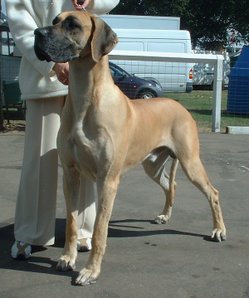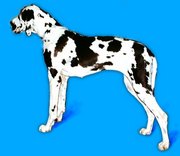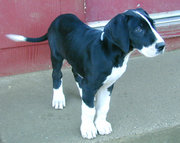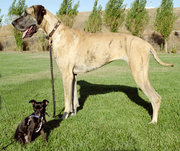
German Mastiff
Alano
Dogue Allemand
Grand Danois
Dog Niemiecki
|
From Wikipedia the free encyclopedia, by MultiMedia |
| Great Dane | ||
|---|---|---|

Fawn coat color
|
||
| Alternative names | ||
| Deutsche Dogge German Mastiff Alano Dogue Allemand Grand Danois Dog Niemiecki |
||
| Country of origin | ||
| Germany | ||
| Common nicknames | ||
| Gentle Giant | ||
| Classification and breed standards | ||
| FCI: | Group 2 Section 2 #235 | |
| AKC: | Working | |
| ANKC: | Group7 (Nonsporting) | |
| CKC: | Group 3 (Working) | |
| KC (UK): | Working | |
| NZKC: | Nonsporting | |
| UKC: | Guardian Dogs | |
| Not recognized by any major kennel club | ||
| This breed of Dog is extinct | ||
| Notes | ||
The Great Dane is a breed of Dog known for its large size and gentle personality. The breed is commonly referred to as the "Gentle Giant".
 Harlequin coat color
Harlequin coat color
There are six show-acceptable coat colors for Great Danes.
Other colors occur occasionally but are not acceptable in the show ring. Because they are not valid for show Dogs, they are not pursued by breeders. These colors include white, fawnequin, merle, merlequin, fawn mantle, and others. These are sometimes advertised as "rare" colors to unsuspecting buyers. Any coat that includes "mouse grey" is disqualified from show.
Cropping of the ears is common in the United States and much less common in Europe. Indeed, in some European countries, in parts of Australia, and in New Zealand, the practice is banned, or controlled such that it may only be performed by veterinary surgeons for health reasons.
Height and weight requirements for show Dogs vary from one kennel club's standards to another, but generally the minimum weight falls between 100 to 120 lb (46 to 54 kg) and the minimum height must be between 28 and 32 inches (71 to 81 cm) at the withers. Most standards do not specify a maximum height or weight. In August 2004, a Great Dane named "Gibson" from Grass Valley, California was recognized by the Guinness Book of Records as the world's tallest Dog, measuring 42.2 inches at the withers. [1]
Typically they are smart, strong Dogs who are protective and loyal to their owners. Many are gentle and delicate, although not to the extent of being timid. They take to training well and are fairly low maintenance compared to many other breeds. The Great Dane must be spirited, courageous, always friendly and dependable, and never timid or aggressive.
 Puppy with mantle coat
Puppy with mantle coat
Great Danes, like most giant Dogs, have a fairly slow metabolism. This results in less energy and less food consumption per pound of Dog than in small breeds.
Great Danes have some health problems that are common to large breeds. Bloat (a painful distending and twisting of the stomach) is a rare but critical condition that affects Great Danes and results rapidly in death if not quickly addressed. It is a commonly recommended practice for Great Danes to have their stomachs tacked (Gastropexy) to the interior rib lining during routine surgery such as spaying and neutering if the Dog or its relatives have a history of bloat. Another problem common to the breed is in the hips (hip dysplasia). Typically an x-ray of the parents can certify whether their hips are healthy and can serve as a guidline for whether the animals should be bred and are likely to have healthy pups.
Dilated Cardiomyopathy (DCM) and many congenital heart diseases are also commonly found in the Great Dane.
Great Danes also suffer from several genetic disorders that are specific to the breed. For example, if a Great Dane lacks color (not white) near its eyes or ears then that organ does not develop and the Dog will be either blind or deaf.
 The brindle coat can be lightly brindled, as here, or with more distinctive
stripes.
The brindle coat can be lightly brindled, as here, or with more distinctive
stripes.
Often referred to as the "Apollo of Dogs", the Great Dane we know today is thought to have originated from larger German Bullenbeisser Dogs. The Bullenbeisser was used in Germany for hunting large wild boar. Some texts about Great Danes say this breeding was accidental. There are also those who believe that the Great Dane was created by crossing a Greyhound with an English Mastiff. The origin of the "Dane" appellation is unclear; the breed almost certainly did not originate in Denmark, and indeed is still known in German as the Deutsche Dogge and in French as the Dogue Allemand, both meaning "German mastiff".
The Great Dane is the state Dog of Pennsylvania.
The Great Dane is the team mascot at the University at Albany.
Dogs, made by MultiMedia | Free content and software
This guide is licensed under the GNU Free Documentation License. It uses material from the Wikipedia.